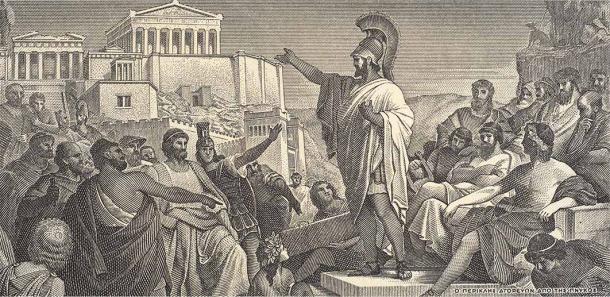Visiting A Time Capsule Of Periclean Athens
A time-traveler considering taking a stroll through Periclean Athens has a very narrow window of time to visit Athens in its heyday. Pericles, sometimes noted as the greatest statesman of Athens, came to power in 448 BC but died of the plague in 429 BC. For a period of 50 years, Athens had time to recover from war and Pericles transformed Athens into the most spectacular city on the face of the earth. However, the Peloponnesian War, in which Athens and her allies fought against Sparta and her allies, broke out in 431 BC. So, it is advised to visit the city a year or two before it becomes obvious that the two sides are on a collision course - one that will ultimately lead to Athens’ defeat and the loss of her maritime empire.

Pericles delivering his famous Funeral Oration at the end of first year of the Peloponnesian War ( vkilikov/ Adobe Stock)
Arrival at Piraeus
It is recommend to arrive by sea, disembarking at Piraeus in the largest of its three harbors, known as Kantharos or Goblet because of its shape. Kantharos is where all the commercial shipping docks, while the two smaller harbors, Zea and Mounychia, are reserved for Athens’ huge fleet of triremes, which are housed in the surrounding ship sheds. Triremes are so called because they have three tiers of oars. They can reach nine knots an hour and virtually turn on an obol. All three ports are a positive hive of industry and activity. Many metics - permanent foreign inhabitants - have established sanctuaries to their outlandish gods in the Piraeus, swarming with hundreds of sailors, for obvious reasons. Service in the fleet is a full-time activity and provides a livelihood for the poor. Athens only became a naval power in 482 BC, two years before the Battle of Salamis against the Persians, and henceforth the rowers became essential to her survival and prosperity.
The big island just over a mile away (two kilometers) is Salamis and the battle was fought between the straits. Back in 480 BC, civilians, including Pericles as a young boy, had to evacuate to Salamis in advance of the Persian invasion of Attica, Attica being the territory surrounding Athens. Imagine Pericles standing on the shore watching his city erupting in flames and the battle raging, and knowing that if Athens lost the Persians would immediately round up all the civilians, kill all the men, and enslave all the women and children.
Like this Preview and want to read on? You can! JOIN US THERE ( with easy, instant access ) and see what you’re missing!! All Premium articles are available in full, with immediate access.
For the price of a cup of coffee, you get this and all the other great benefits at Ancient Origins Premium. And - each time you support AO Premium, you support independent thought and writing.
Dr Robert Garland obtained his M.A. in Classics from McMaster University and his Ph.D. in Ancient History from University College London. His research focuses on the social, religious, political, and cultural history of both Greece and Rome. He has written 17 books including Ancient Greece: Everyday Life in the Birthplace of Western Civilization.
Top Image: Like all Greeks Athenians love to argue (jambulart/ Adobe Stock)
















